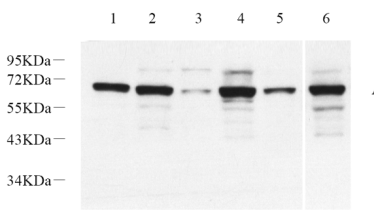| Reactivity: | H,M,R |
| Applications: | WB |
| Host Species: | Rabbit |
| Clonality: | Polyclonal |
| Full Name: | AKT rabbit polyclonal |
Gene Name: | v-akt murine thymoma viral oncogene homolog 1 |
Synonyms: | AKT1, AKT, CWS6, PKB, PKB-ALPHA, PRKBA, RAC, RAC-ALPHA,AKT serine/threonine kinase 1 |
Immunogen: | Recombinant protein corresponding to Human AKT |
Isotype: | IgG |
Purity: | Affinity purification |
Predicted MW. | 56 kDa |
Observed MW. | 60 kDa |
Uniprot ID: | P31749, P31750, P47196 |
Product Usage Information
Applications | Species | Dilution | Positive tissue |
WB | Human, Mouse, Rat | 1: 1000-1: 2000 | Jurkat, MCF7, HT29, HCT116, SW480, lung |
Background
RAC-alpha serine/threonine-protein kinase is an enzyme that in humans is encoded by the AKT1 gene. This enzyme belongs to the AKT subfamily of serine/threonine kinases. It is commonly referred to as PKB, or by both names as "Akt/PKB". The serine-threonine protein kinase AKT1 is catalytically inactive in serum-starved primary and immortalized fibroblasts. AKT1 and the related AKT2 are activated by platelet-derived growth factor. The activation is rapid and specific, and it is abrogated by mutations in the pleckstrin homology domain of AKT1. In the developing nervous system AKT is a critical mediator of growth factor-induced neuronal survival. Survival factors can suppress apoptosis in a transcription-independent manner by activating the serine/threonine kinase AKT1, which then phosphorylates and inactivates components of the apoptotic machinery.
Images
 | Western blot analysis of AKT (GB13427) at dilution of 1: 1000 Lane 1: Jurkat cell lysate Lane 2: MCF7 cell lysate Lane 3: HT29 cell lysate Lane 4: HCT116 cell lysate Lane 5: SW480 cell lysate Lane 6: Mouse lung tissue lysate |
Storage
| Storage | Store at -20°C for one year. Avoid repeated freeze/thaw cycles. |
| Storage Buffer | PBS with 0.02%sodium azide,100 μg/ml BSA and 50% glycerol. |
